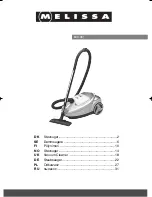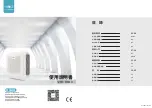
5
ENGLISH
b. Remove any adjusting key or wrench before
turning the power tool on.
A wrench or a key left
attached to a rotating part of the power tool may
result in personal injury.
c. Do not overreach. Keep proper footing and
balance at all times.
This enables better control of
the power tool in unexpected situations.
d. Dress properly. Do not wear loose clothing or
jewellery. Keep your hair, clothing and gloves
away from moving parts.
Loose clothes, jewellery
or long hair can be caught in moving parts.
e. If devices are provided for the connection of
dust extraction and collection facilities, ensure
these are connected and properly used.
Use of
dust collection can reduce dust-related hazards.
4. Appliance use and care
a. Before use, check the appliance for damaged
or defective parts.
Check for breakage of parts,
damage to switches and any other conditions that
may affect its operation.
b. Do not use the appliance if the switch does not
turn it on and off.
Any appliance that cannot be
controlled with the switch is dangerous and must be
repaired.
c. Disconnect the plug from the power source
and/or the battery pack from the appliance
before making any adjustments, changing
accessories, or storing appliances.
Such
preventive safety measures reduce the risk of
starting the appliance accidentally.
d.
Where applicable, keep cutting tools sharp and
clean. Properly maintained cutting tools with sharp
cutting edges are less likely to bind and are easier to
control.
e.
Do not use the appliance if any part is damaged or
defective.
f.
Have any damaged or defective parts repaired or
replaced by an authorised repair agent.
g.
Never attempt to remove or replace any parts other
than those specified in this manual.
5. Battery tool use and care
a. Ensure the switch is in the off position before
inserting battery pack.
Inserting the battery pack
into appliance that have the switch on invites
accidents.
b. Recharge only with the charger specified by
the manufacturer.
A charger that is suitable for
one type of battery pack may create a risk of fire
when used with another battery pack.
c. Use appliance only with specifically
designated battery packs.
Use of any other
battery packs may create a risk of injury and fire.
d. When battery pack is not in use, keep it away
from other metal objects like paper clips,
coins, keys, nails, screws, or other small
metal objects that can make a connection from
one terminal to another.
Shorting the battery
terminals together may cause burns or a fire.
e. Under abusive conditions, liquid may be
ejected from the battery; avoid contact. If
contact accidentally occurs, flush with water.
If liquid contacts eyes, additionally seek
medical help.
Liquid ejected from the battery may
cause irritation or burns.
After use
•
When not in use, the appliance should be stored in a
dry, well ventilated place out of the reach of children.
•
Children should not have access to stored
appliances.
•
When the appliance is stored or transported in a
vehicle it should be placed in the boot or restrained
to prevent movement following sudden changes in
speed or direction.
Safety of others
•
This appliance
is not intended for use by persons
(including children) with reduced physical, sensory or
mental capabilities, or lack of experience and
knowledge, unless they have been given supervision
or instruction concerning the use of the appliance by
a person responsible for their safety.
•
Children should be supervised to ensure that they do
not play with the appliance.
6. Service
a. Have your appliance serviced by a qualified
repair person using only identical replacement
parts.
This will ensure that the safety of the power
tool is maintained.
ADDITIONAL SAFETY INSTRUCTIONS
FOR BATTERIES AND CHARGERS
Batteries
•
Never attempt to open for any reason.
•
Do not expose the battery to water.
•
Do not expose the battery to heat.
•
Do not store in locations where the temperature may
exceed 40°C.Charge only at ambient temperatures
between 10°C and 40°C.
•
Charge only using the charger provided with the
appliance/tool. Using the wrong charger could result
in an electric shock or overheating of the battery.
•
When disposing of batteries, follow the instructions
given in the section "Protecting the environment".
•
Do not damage/deform the battery pack either by
puncture or impact, as this may create a risk of
injury and fire.
•
Do not charge damaged batteries.
•
Under extreme conditions, battery leakage may
occur. When you notice liquid on the batteries
carefully wipe the liquid off using a cloth. Avoid skin
contact.
Summary of Contents for Powerful Solutions PV96610
Page 1: ... PV9610 PV1210 PV1410 PV1810 www blackanddecker com au ...
Page 2: ......
Page 3: ...3 L ...
Page 4: ......
Page 6: ......
Page 8: ......


























